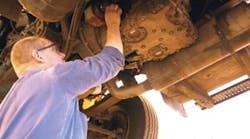It is a tragedy that could still happen in any shop.
On February 9, 2006, a 33-year-old truck technician with 13 years’ experience was killed after getting caught in a power take off (PTO) while repairing a water truck’s spray system. Working underneath the truck while it was still running, a protruding set screw on the PTO drive shaft caught the collar of his coveralls and quickly entangled him.
According to the National Institute for Occupational Safety and Health, two truck drivers were killed this year in PTO-related accidents. Bob Johnson, director of fleet relations with the National Truck Equipment Association (NTEA), says these deaths are preventable with some common sense and consistent maintenance.
“If the PTO shaft is turning, stay out from under the truck,” he says. “A lot of (PTOs) have square-headed set screws for tightening down the yokes on the shaft, and that’s just a guaranteed thing to catch (clothing). The most common reason people are up underneath the truck is because it didn’t shift properly—either it didn’t go in or it didn’t release, and they’ll get under there and try to knock it out, and they’ll get their sleeve caught in the PTO and wrapped up and that’s the end of it.
“That’s the reason it’s so critical to make sure the shift linkage is properly working—just double-check that everything is in gear properly.”
PTO BASIC TRAINING
Aside from the obvious dangers, maintaining PTOs is fairly standard. Dave Douglass, director of training at the Muncie, IN-based Muncie Power Products, says the biggest change in recent years is the devices’ increasing integration with electrical systems, which can cause engagement and operations problems for installers.
“Before automatic transmissions got very popular, putting a PTO on a manual transmission was pretty much a mechanical connection—making sure that the gear of the PTO meshed properly with the gear of the transmission, and hooking up some kind of a mechanical linkage, and it was a very mechanical, relatively simple installation,” he says. “As automatic transmissions became more popular, where they started having to interface, not just mechanically with the transmission, but also interface electrically with the vehicle; that’s where a lot of installation problems started to occur, and our experience has been that a lot of that has been simply due to electrical errors rather than mechanical errors. There is a lot of stuff to keep track of, and the vehicle OEMs sometimes aren’t as good as they should be about communicating changes to the people that have to do the installations, so there tends to be a lot of confusion at the level of the installer.”
Muncie offers PTOs for both automatic and manual transmissions for a variety of applications, though there is more for a technician to be aware of with automatics, Douglass says.
“PTOs for automatic transmissions are usually what are referred to as a clutch-type PTOs, where you have friction disks inside that perform the engagement, and in manual transmissions, the PTOs tend to be just a mechanical shift, where you have one gear moving in and out of mesh with another gear,” he says. “So the PTOs for automatics have more parts, but troubleshooting-wise, most PTO problems have to do with—if the initial installation was performed properly—an operator not following the proper shifting procedures. And if that’s a manual transmission, what that usually means is they’re not disengaging the clutch before they try to engage the power take off, and if it’s an automatic transmission, one of the most common things is engaging the PTO at too high an engine speed.”
Douglass says PTOs—while still potentially dangerous—are much easier to repair these days because equipment installers are using direct coupled hydraulic pumps instead of remote-mounted pumps, in order to eliminate the troublesome driveshaft.
“Not that we even recommend anyone get under a truck while it’s running,” he says.
PTO MAINTENANCE
Technicians who follow basic maintenance procedures should have no problems with PTOs, says Douglass.
“Read the installation manuals thoroughly, follow all the steps and pay particular attention to the wiring, especially if it’s an automatic transmission,” he says. “Because those are the areas where installers have the most problems, and those tend to be the areas, from a maintenance standpoint, where after time, things start to act up, if wiring connections aren’t good or become corroded, the PTO starts to behave erratically, that’s usually an indication of an electrical problem.”
NTEA’s Johnson says the first thing to do when you put a new truck in service is to check the backlash—the free movement between two meshing gears on the PTO.
“I know (the PTO) was installed by a so-called professional who should know what they’re doing, but that doesn’t guarantee they do,” he says. “If (the PTO is) too tight, you’re going to burn the PTO drive gear up; if (it’s) too loose, you’re going to get a lot of noise and gear damage. Also, check if they’re air or electric shift; make sure they’re shifting properly.”
For manual transmissions, technicians will have to put a clutch in, which requires some additional work, Johnson says.
“You have to remove the PTO in the process of changing out the transmission because it’s usually in the way,” he says. “When they bolt it back up, they put it back in the exact same (place). That’s a good starting point; you should double-check the mesh of the gears. If you’ve done any work on the transmission—changed bearings, replaced components—it becomes especially critical to re-check the shimming of the PTO, just to make sure they’re meshing properly.
“Chances are it will be, but every now and then it may get torqued a little tighter, the gasket could have crushed a little, or the new gasket has a little bit different thickness than the old gasket,” Johnson says. “Anytime you remove a PTO from a transmission, when you re-install it, double-check the shifting to make sure it’s shifting properly, double-check the backlash of the gears to make sure it’s shimmed properly, things of that nature.”
TRANSMISSION TRANSITION
While the PTO market has not changed drastically, there has been a significant shift in transmissions, with automatic and automated options becoming much more prevalent in medium-duty work trucks,
Johnson says, so lesser experienced drivers can handle them with more ease.
“If you’re a power company, you hire a lineman or a cable splicer, you don’t hire a truck driver,” he says.
Allison Transmission manager of service technology Keith Duner says the company has adapted its products to account for these operators.
“If you look at all the different vocations that are running down the street, most do not have trained truck drivers operating them, so you have the ability to stick someone in a vehicle who is less than a fully trained, 8-12-14-speed capable truck driver and sit behind the wheel of something that drives like the family automobile,” he says. “And the safety inhibits that are inherent in both the physical design and the electronic control system, further protect (against) operator abuse.”
Duner says while the driver shortage has hastened the acceptance of automatics, it is important to distinguish between automatic and automated.
“Automated manual transmissions are not automatics, as they still have a clutch to maintain or burn up,” he says.
AUTOMATED TRANSMISSIONS
Dontia Warren, NAFTA medium-duty market development and strategy manager for Eaton Truck Components, says automated transmissions like their UltraShift HV can increase driver safety while reducing fatigue from shifting, particularly in urban environments.
“What it does for that driver… is remove the clutch pedal from the cab, it removes the shift lever, and they simply maneuver the throttle and the brake,” she says. “By taking an automated approach versus going to an automatic, you’re going to have fuel efficiency gains with our products that you would not be able to realize with an automatic transmission.”
Warren says Eaton’s UltraShift HV transmissions are compatible with all major PTO suppliers, and require no servicing other than routine inspections to ensure the bolts are properly secured.
“From the factory, it is going to come with synthetic lubricant, so there’s no need to touch this transmission, there’s no filters required and there’s no lubricant changes required,” she says. “It’s just drive and go.”
A relatively new addition to the medium-duty market is Eaton’s hybrid transmission, with its engine-off PTO function, which means a user or driver can run the PTO without having the engine on, saving fuel, noise and emissions.
“The desire for utility companies is to be able to not have their engine running the entire time they’re at the job site,” Warren says. “With this ePTO feature, it allows the operator to turn the vehicle off and run the PTO, just using an electric motor powered by the batteries with the hybrid system, so that’s definitely a value add.”
TRANSMISSION TIPS
Staying on top of fluid and filter change intervals is critical, says Duner, particularly in automatics.
“In an automatic transmission, fluid does much more than just cool—it lubricates, it transmits power, it applies clutches, it carries dirt away—so utilization of the correct fluid for the vocational type and the product is equally important because of the wide variety of transmission applications we support,” he says. “We look at mileage or hours, whichever comes first. These are commercial vehicles; they are designed to do one thing—make money for somebody, and they can’t do that if they’re broken down. It’s all about uptime.”
Many technicians assume transmission problems are electrical-related, Duner says, but first investigating the cause of trouble can save time and money.
“Look at fluid levels, look at installation items, rub-throughs on wire harnesses, chafing on hydraulic hoses, look at the integrity of the vehicle cooling system,” he says. “Automatic transmissions generate heat, they share the cooling system with the engine; we want to keep the coolant on the right side of the oil cooler and the transmission fluid on the other side of the oil cooler—the two shouldn’t mix.”
If there’s an indication of a failure there, it can bring glycol contamination into the transmission, Duner says, which will shorten the life of the clutch disks within the transmission. Conversely, if you get oil in the water side of the cooling system, then the overall efficiency of the cooler diminishes accordingly.
“Do the basic walk-around on a vehicle,” he says. “Transmissions should not leak, so if there is a leak, it should be addressed with some speed. Any issue of severity will turn on an indication to the consumer that there is a problem—that could be as simple as a check transmission light or it could be as severe as a fail in range response to a significant failure, that says, ‘Something bad is going on, I’m going to stay in the range I’m in, not allow upshift or downshift until the operator pulls off to the side of the road and seeks council in getting that repaired.’ So there are severity indicators relative to the output of the electronic control system as it self-monitors its condition.”
NOT SO AUTOMATIC
While transmissions are generally trouble-free, Johnson says, automatics present greater challenges for technicians.
“Filtration is extremely critical on those,” he says. “I would definitely recommend a regular program for servicing automatic transmissions, changing fluid and filters, making sure the coolers are operating properly; that they’re clean enough.”
Heat is the biggest enemy of automatics, Johnson says, which makes proper cooling all the more important.
“There are number of things that can cause an automatic transmission to overheat—the cooling radiator is clogged up or damaged and you’re not getting adequate cooling fluid—both low and high fluid levels will cause problems,” he says. “If you put too much in, you’ll get foaming, which causes a number of problems. It’s critical to maintain the proper level of fluid, and make sure you know what the process for checking it is for that particular transmission.”
Manuals—other than needing fluid levels checked and possibly changed once— are basically trouble-free, Johnson says, but there are still things to watch out for.
“I would suggest to periodically pop the plug out and check for excessive build-up,” he says. “And always be sure the clutch is working properly and fully releasing.”
Technicians doing routine service on transmissions or PTOs should always test-drive the vehicle afterwards to check for unusual noises. Johnson says even equipment right from the dealer or factory should be thoroughly examined before going into service.
“One of the most critical things with any transmission equipped with a PTO when you first put it into service is to make sure it’s right, and if it’s not right when you put it in service, you can guarantee you’re going to have problems—not installed properly, not shifting properly, not adjusted properly—and just because it came from the dealer or the factory, that’s not a 100 percent guarantee it’s going to be installed properly,” he says.
Lastly, technicians who maintain vehicles that operate in dirty conditions need to watch for dirt around the transmission, Johnson says, particularly if they have a PTO with a mechanical shift mechanism or an external pneumatic shifter.
“Dirt packed in around the transmission will impede cooling, because you get cooling from the surface of the transmission,” he says. “On an off-road vehicle—especially one with a skid plate—you want to clean the dirt from the skid plate to make sure the transmission is cooling properly. The rest is just good common sense.”
SAFETY FIRST
These days, maintaining transmissions and power take-offs is one of the less-complicated jobs your technicians are going to be faced with. Keep the coolant and filters fresh, and keep up with your PM schedule, and your fleet should be running smoothly down the road.
Still, with the potential for grave injury or death when fixing malfunctioning power take-offs, safety must always be the first concern in your shop and needs to be stressed at all times, particularly with inexperienced technicians. Don’t take any chances.
Perhaps Muncie Power Products’ Douglass put it best:
“We tell people the first step in working on a power take-off is to take the keys out of the ignition and put them in your pocket.”



